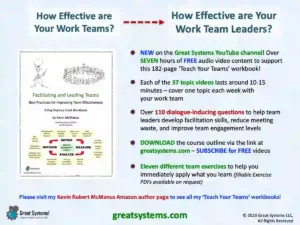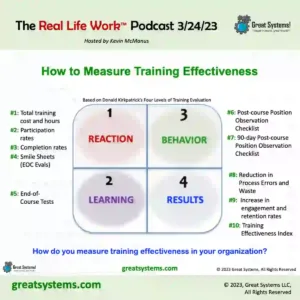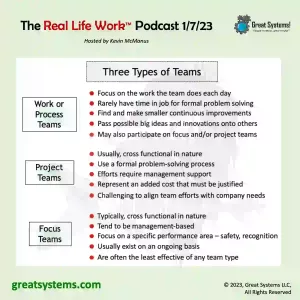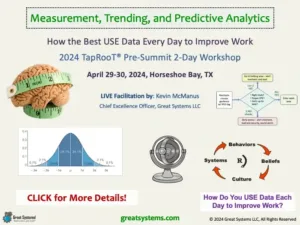How do you measure and improve your training work system?
Measure and Improve Your Training and Learning Work System
How do you measure and improve your training and learning work system? Begin with more in-class practice and on the job skill reinforcement. Read on for more best practice ways to improve how you help others learn.
Back in 1990, I first became aware of how practice fields drive true learning when I read Peter Senge’s book The Fifth Discipline. The follow-up book, The Fifth Discipline Fieldbook, expanded further on this concept. The following thoughts on the need to measure and improve our training and learning work system are taken from the first book. They apply to learning, training, and teams who ideally strive to learn more from each other.
“In most business team environments, people use time to make decisions about specific situations, which are often debated and decided under great time pressure, with each decision being final as soon as it is made. There is no experimentation with options. Worse still, there is little opportunity to form reasoned assessments of the wisdom of different decisions.”
In such a time-sensitive world, how can we take the time to practice? Practice fields come in two forms – actual skill practice and computer simulations. If you want a supervisor to get better at conflict resolution, then she needs to do more than read a list of tips on the topic. She needs several practice repetitions, with quality feedback being part of each rep, to make real learning happen. Practice excellence to be excellent!
LEARN MORE: How Does Your Work Team Structure Drive Operational Excellence?
Top 10 Training Work System Design Flaws
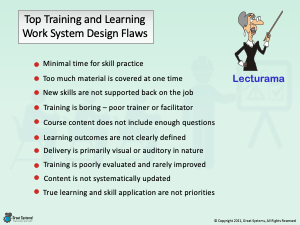
Does Your Training and Learning Work System Waste Learning Time?
I would like you to take a couple of minutes to reflect on three questions. First of all, how many hours of training do you think takes place in the business world each day? Second, what is the total cost of that training?
Third, if we tested each trainee on the material he or she covered two weeks ago today, how much of that material would they really remember? In other words, what did they really learn?
I have my opinions when it comes to training effectiveness. In general, they are not positive ones. Unfortunately, they are also based largely on personal experience and observation. Over the last 11 years alone, I have facilitated more than 10,000 classroom hours.
I feel that the research exists, albeit qualitative, to justify my feelings. I think most of the training that occurs each day in business is a waste of time! We spend the time, but the right stuff does not get into long term memory. Learning does not occur!!
A review of my list of training system weaknesses should help show you why I feel this way. I am also aware however of what I have forgotten. I admit a lack of use of many things others taught me over the years. Some of it was not relevant. Some of it I did not understand. Most of it, I forgot.
As I spent more time as a trainer myself, I eventually began to find better ways to design a training and learning work system to help promote and sustain skill retention and application.
Why Practice is Needed to Drive True Learning
Exploring the world of sports from a systems perspective over the past 35 years has helped me really understand the need for practice when it comes to true, effective learning. I was already convinced that you had to practice in sports if you wanted to get better.
What I had yet to realize is that most of the skills we expect managers and supervisors to know and use in a high performance workplace (or in most workplaces for that matter) require a lot of practice IF we expect people to become proficient at – really learn – those skills!
Think about it. How much practice time have you been given to learn new skills on the job? Have you been getting enough practice to really become good at the key skills you are expected to know? How much can you really learn when you are trying to practice while the game is going on?
As for the daily cost of training … I stopped thinking a lot about it once I saw that we were easily wasting a million dollars a day. For example, 100 managers at a $35 hourly wage rate receiving 8 hours of training at 50 different locations will give you a daily cost of $1.4 million! I sure hope that those 5,000 managers use what they spent that money for.
A More Effective Approach to Training and Learning Work System Design
There was a point in time where I too as a trainer relied mainly on lecture to deliver the material I was supposed to teach to others. I simply did not realize that it made that much difference!
I had two eye opening events occur during the 1990s that really shifted my own paradigms about how training needed to be delivered if a company even expected to have a chance of it being understood, retained, and applied. The first experience involved teaching a two-day statistical process control (SPC) class to my food plant supervisors. The training seemed to go well enough.
Later, I learned that part of the trainees’ cooperation had to do with the fact that many of them had only a third grade level of math literacy. In turn, they didn’t know what was going on with all of those decimal points!
Why did I do this? Because that is the main way that others had taught me since I entered the world of formal education at the age of five. From the short term perspective, it is much less painful to teach in a manner we are personally familiar with than it is to learn to teach differently. Who cares if anyone remembers or uses anything or not, right?
Baldrige Examiner Training
The second event occurred when I went to my first National Baldrige Examiner training session. As this was being put on by a group associated with the Federal government, I assumed that it was going to be two plus days of boring lecture.
Instead, I was part of a highly interactive set of exercises that really did encourage learning. That experience really shifted my paradigms about training effectiveness.
The first experience taught to never assume anything when preparing to deliver a training class. The second event showed me how there are highly effective alternatives to lecture out there if one truly wants effective learning to occur.
Since that point in time, I have modified all of my training packages to be exercise focused. Try to build at least 50% practice time into your learning event lesson plans. You’ll like the effective task performance results you’ll see!!
10 Great Training Work System Changes!
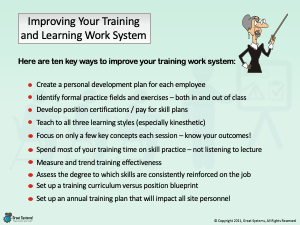
How Can You Measure and Improve Your Training and Learning Work System?
For over forty years, I have helped many different companies – both small and large – design an effective training and learning work system. This experience has helped me discover value added, simple ways to set up training curriculums, personal development plans, certification programs, and effectiveness measures to support a high performance workplace.
Lecture and computer-based training are two key power restrictors for the training and learning work system. The above tools help you both minimize these barriers. Plus, they help you move forward more rapidly towards higher levels of learning and performance.
Keep improving!
Kevin McManus, Chief Excellence Officer, Great Systems
WATCH over 50 kaizen and workplace health improvement videos on my Great Systems YouTube channel.
CHECK OUT my ‘Teach Your Teams’ workbooks on Amazon.com
LIKE Great Systems on Facebook
© Copyright 2024, Great Systems LLC, All Rights Reserved
